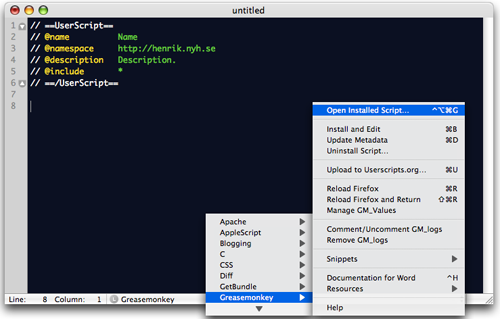

- TEXTMATE XML BUNDLE INSTALL
- TEXTMATE XML BUNDLE SERIAL
- TEXTMATE XML BUNDLE SOFTWARE
- TEXTMATE XML BUNDLE CODE
- TEXTMATE XML BUNDLE PASSWORD
TEXTMATE XML BUNDLE PASSWORD
Query=$īut this requires that I expose the username and password.ĭo you know if its possible to either obfuscate at least the password or I know I can easily hack this in a very simple/basic/dumb way $ORA_CONNECT (set in env) in each file/script in lets say the first line. Since I regularly have to connect to multiple servers it would be nice if IĬould override the default connection parameters $ORA_USER, $ORA_PWD, I had to also change the I am a programming noob, just wanted to see if the following would be Here are the few changes I made for your reference:
TEXTMATE XML BUNDLE INSTALL
I had to make the following changes to get it to work on my Macbook Pro,Įspecially since I don’t have a full Oracle install on my Macbook and only I have been playing with it and liked it so far.īefore I forget, Thank you for creating it!. I used to test stuff in oracle) till I found your TM Oracle bundle last Quite a bit of time switching between TM and Aqua Data Studio (which is what Most of the work I amĭoing is a mix of XML and SQL (both MySQL and Oracle). I have been using TextMate for most of my work lately. This “preview” has the following commands: The syntax just piggybacks on the SQL syntax from the SQL bundle, and I haven’t added any support for PL/SQL. So far, it’s only got a few basic features, but I’m hoping to add more as time allows for it.
TEXTMATE XML BUNDLE CODE
I could possibly have added Oracle functionality to the existing SQL bundle, but there didn’t seem to be a lot of overlap between MySQL/Postgres and Oracle in terms of the code implementing the bundles, so I decided to create a standalone bundle. So, without tiring you with more chatter, I present my first TextMate bundle, the Oracle Bundle. The supplied SQL bundle works only with MySQL and Postgres, and Google wasn’t any help in finding a bundle specifically for Oracle.Īfter spending a few hours looking into what these TextMate bundles are, it turns out they’re very, very nifty and it’s not all that difficult to create your own. I’ve been using it more and more lately, but unfortunately there’s no support for working with Oracle databases. My editor of choice is TextMate, one of the very first applications I bought for my Mac. For example, create a folder called “blink” and save your code in a file called “blink.pde”.After reading The Pragmatic Programmer this summer, I’ve been trying to follow some of their tips, one of them beingĬhoose an editor, know it thoroughly, and use it for all editing tasks. Note that you need to save your Arduino code (“sketch”) into a directory and file with the same name. Here are the settings which worked for me: ARDUINO_PORT ?= /dev/cu.usbmodem411 I also had to change the upload rate (serial baud rate) to “115,200” to get it to work properly. On a Mac (Snow Leopard v10.6.5), the UNO shows up as the device “/dev/cu.usbmodem411”. I have an Arduino UNO, which has the “atmega328p” processor. The device name is the new one that shows up. Check your device list before you connect your Arduino, and then check it again after you connect it. (Some tutorials suggest using “/dev/cu.usbmodemXXX” instead of the “tty.” device name on the Mac, but i’m not sure why.)įrom Terminal.app, you can also list which devices show up when you connect your Arduino via USB.
TEXTMATE XML BUNDLE SERIAL
Check that the “Tools > Board” menu it properly set to “Arduino UNO”, and the “Tools > Serial Port” menu should identify the device name you are using (likely “/dev/tty.usbmodemXXX” or something similar).
TEXTMATE XML BUNDLE SOFTWARE
When you installed the Arduino software environment on your Mac, it probably correctly identified your Arduino when you plugged it into the USB port. I am currently working on integrating XSLTproc (the command-line processor that comes with libXSLT) into TextMate and e Texteditor (the Windows Textmate clone). These settings are used when you use the “Upload” (⌘U) command in TextMate. The Makefile should be in the “Support” folder. To access the Makefile, right-click on the “Arduino.tmbundle” stored in ~/Library/Application Support/TextMate/Bundles and choose “Show Package Contents”. To get it to work, I had to tweak the Makefile included in the bundle. Using the command-line tools included with the latest Arduino software package, you can compile and upload Arduino programs right from within TextMate! I chose to install the Arduino TextMate Bundle from nasser. There are several TextMate bundles for Arduino available on Github. As nice as it is, i’d prefer to write code using TextMate, my programming weapon of choice. The Arduino environment includes an IDE that enables you to write a program in the Arduino programming language, and upload it to your board.


 0 kommentar(er)
0 kommentar(er)
